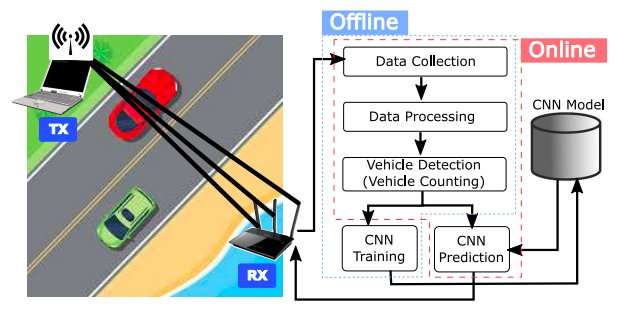System architecture of DeepWiTraffic. Credit: Won, Sahu & Park.
A team of researchers at the University of Memphis has recently developed a low-cost and portable traffic monitoring system (TMS) called DeepWiTraffic. This new system, presented in a paper pre-published on arXiv, combines Wi-Fi devices and deep learning.
TMSs are a key component of intelligent transportation systems (ITS), which are aimed at improving the safety and efficiency of transportation. TMSs collect traffic data related to the performance of a roadway system, measuring parameters such as number of passing vehicles, as well as vehicle density, speed, and class.
In the United States, the Department of Transportation (DOT) in every state is tasked with collecting traffic information about vehicles traveling across highways and roads. The TMSs used to automatically count and classify vehicles can be either temporary or permanent.
"An endemic issue for many state DOTs is the high cost for deploying a sufficient number of TMSs to cover the gigantic land area of the U.S., especially considering the huge miles (119,247) of rural highways," the researchers wrote in their paper. "According to the Georgia DOT, the minimum cost to install a continuous TMS on a two-lane rural roadway is about $25,000, and 365-day vehicle classification on a two-lane rural roadway is more expensive, costing about $35,770."
In their recent study, the researchers addressed the challenges associated with the high cost of existing TMSs by developing an innovative and low-cost approach to traffic monitoring based on Wi-Fi channel state information (CSI) and deep learning. Their TMS employs non-intrusive vehicle detection and classification techniques, using distinctive wireless channel characteristics to classify passing vehicles.
"DeepWiTraffic enables accurate vehicle detection and classification by exploiting the unique WiFi channel state information (CSI) of passing vehicles," the researchers explained in their paper. "Spatial and temporal correlations of preprocessed CSI amplitude and phase data are identified and analyzed using deep learning to classify vehicles into five different types: motorcycle, passenger vehicle, SUV, pickup truck, and large truck."
In wireless communications, CSI refers to the channel properties of a communication link, describing how the signal travels from the transmitter to the receiver. CSI includes rich information about the changes in the channel properties caused by passing vehicles, which can be used to classify vehicles.
The researchers designed a convolutional neural network (CNN) that can automatically capture the optimal features of CSI data and then trained a vehicle classification model on pre-processed CSI data. They also used other techniques to improve the model's classification accuracy, for instance, by mitigating the effects caused by obstacles surrounding vehicles, including objects or people moving at low speed.
DeepWiTraffic was tested on a large amount of CSI data of passing vehicles and corresponding ground truth video data, for a total of approximately 120 hours. It attained an average detection accuracy of 99.4 percent and an average classification accuracy of 91.1 percent, despite its low cost of roughly $1000.
"Despite the low cost of the proposed system, the average classification accuracy for five different vehicle types was 91.1 percent, which is comparable to recent non-intrusive vehicle classification solutions," the researchers wrote in their paper. "We expect that DeepWiTraffic will contribute to solving the cost issue of deploying a large number of TMSs to cover the huge miles of rural highways."
More information: DeepWiTraffic: Low cost WiFI-based traffic monitoring system using deep learning. arXiv:1812.08208 [cs.CY]. arxiv.org/abs/1812.08208
© 2019 Science X Network






















